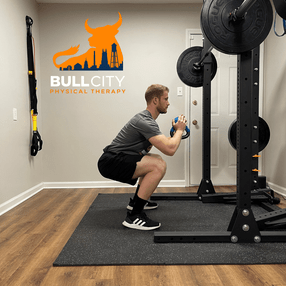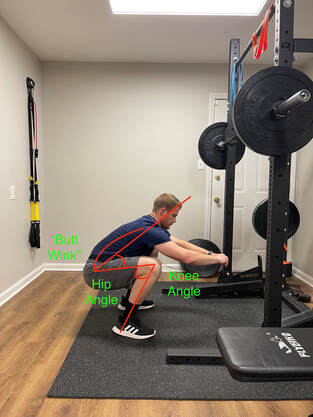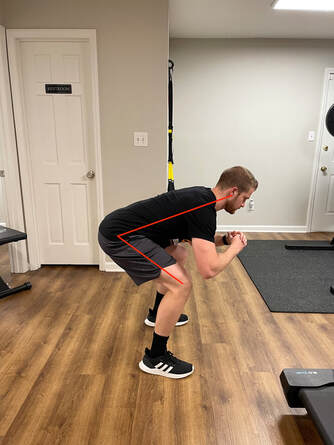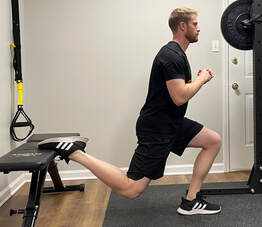
Share:
The squat is one of the most popular exercises for many good reasons. The squat is very functional because we do it throughout our daily life (ie: picking objects off the ground, getting up/down from chair) and it mimics many sport movements. The squat is a compound movement (using multiple joints) that is great for building strength of the lower body, spine, and core musculature. It is estimated that over 200 muscles are activated in the squat. Instead of asking what muscles are activated in the squat, the better question is what muscles are not activated in the squat.

What is normal?
When I was in physical therapy school, professors would often say, “If you understand what normal is, you can figure out abnormal.” That being said, “normal” with squat technique varies depending on the goal of the squat, individual anatomy, and pain/injury history. In the video, I will review squat technique, keeping individual anatomy in mind.
In the pictures below, I show two solid but different techniques for the squat. With “squat technique 1,” you can see my torso is more upright, I am deeper in the squat, and my knees are moving further over my toes than “squat technique 2.” The plates under my heels facilitate more ankle dorsiflexion, which allows for my tibia (shin) to translate further over my feet, resulting in a deeper squat and more upright torso. I am not advocating for squatting with plates under your heels necessarily, instead I used them to demonstrate a more upright torso for squat technique. My poor ankle dorsiflexion range of motion limits my ability to keep my trunk upright without plates under my heels or weightlifting shoes. The upright torso decreases low back and hip strain, but the knees translating further over my toes increases knee strain. This technique is typical with front squats and goblet squats.
Squat Technique 1

Squat Technique 2

With “squat technique 2,” the trunk is more flexed, which places more strain on the low back and hip and but less strain on the knees, making it more friendly for the knee. This technique is typical with barbell back squat, especially low bar back squats. I will cover squat variations in more depth in the next blog.
Compensation #1: The “Butt Wink”
The butt wink is when the low back flexes and the pelvis tilts backwards (posteriorly) at the bottom on the squat. When the body starts ascending out of the bottom of the squat (“the hole”), the low back then must transition from a flexed position back to neutral. Each time the low back transitions, this causes increased strain on the low back and under load, can lead to injury.
The butt wink is only a compensation if it occurs before full depth and the movement is large. Everyone will have a some lumbar flexion if they squat down far enough, and that is normal.

In the picture above, you can see that my low back is rounded at the bottom, causing the butt wink (large amount of lumbar flexion). Using my technique as an example, you can see my knees do not translate over my toes, decreasing the depth the butt wink occurs. Additionally, that is the maximum my hip will flex, which also limits the depth before my low back rounds. I have ankle and hip mobility issues, which is in large part due to my anatomy and not great for deep squatting. With consistent effort, many mobility deficits can be improved, but an individual’s anatomy may cause a ceiling effect on how much it will improve.
The butt wink is primarily caused by mobility deficits of your ankle and/or hips. Clinically, most often I see poor ankle dorsiflexion mobility as the primary culprit. Ankle dorsiflexion allows the tibia (shin) to translate over the foot, which is needed in the descent of the squat.
In addition to ankle dorsiflexion mobility, hip flexion is needed at the bottom of the squat, and if it is lacking, the low back will round to compensate. Tight hamstrings, hip ligaments, and/or certain hip anatomy can all cause poor hip flexion mobility.
The last reason for the butt wink is decreased lumbopelvic (low back and pelvis) stability. “Stability” is a combination of strength and motor control. Motor control is a scientific way of saying that the movement pattern is flawed. This is a result of training a poor movement pattern or improper timing and firing of muscles.
Compensation #2 Exaggerated Forward Trunk Lean

As you can see in the picture, this compensation ends up looking like a combination of a hinge and a squat. People lean their trunk forward because they think they are squatting deeper, but in reality, their head is moving lower because of the trunk lean, which gives the illusion of a deeper squat.
This compensation is almost always a motor control issue. The cue I like to give is “chest up.” If the compensation is due to a motor control issue, cueing with some mental effort should resolve the issue. Bad habits are hard to change. Allow time and consistent practice for the movement pattern to resolve.
Compensation #3: Hips rise before chest (“good morning squat”)
This video shows a compensation where the hips shoot up before the torso during the squat. I rarely see this compensation unless during a heavier loaded squat. This compensation can be a motor control issue or a quadriceps strength deficit.
Compensation #4 Knees caving inward
This video demonstrates the knee caving in (knee valgus) compensation. This compensation is because of a poor motor control, impaired ankle dorsiflexion mobility, and or hip and/or knee strength deficits.
Compensation #5 Low back hyperextension

This last compensation is primarily a motor control issue that people do not realize they are doing. When I see this, often it is because people are trying to keep their back straight (“neutral spine”) to avoid rounding their back and end up overcompensating with hyper-extending the low back. If I see this compensation, I teach a neutral spine and have the athlete practice maintaining that position during lighter weight squats before increasing the weight.
Sometimes this compensation occurs with the “good morning squat” compensation. When the hips raise early, the low back can hyper-extend in an attempt to keep the torso upright.
Final Thoughts
Squats programmed correctly and performed with good technique are safe and have a protective effect from injury. Mobility, strength, and motor control deficits can cause compensations that if unaddressed, can lead to pain and injury. Squatting through pain is not advised, and often there is an underlying impairment or training error that is causing the pain. I have heard many stories of people ditching squats because they have pain when that is usually not needed.
Disclaimer: Articles in the blog are not designed to be medical advice. If you have pain or an injury, I recommend seeing a healthcare professional. To schedule an appointment with Bull City Physical Therapy, visit our clinic page.
Author: Dr. Dylan Michel, PT, DPT
References
- Aasa U, Svartholm I, Andersson F, Berglund L. Injuries among weightlifters and powerlifters: a systematic review. Br J Sports Med. 2017 Feb;51(4):211-219. doi: 10.1136/bjsports-2016-096037. Epub 2016 Oct 4. PMID: 27707741.
- Kubo K, Ikebukuro T, Yata H. Effects of squat training with different depths on lower limb muscle volumes. Eur J Appl Physiol. 2019 Sep;119(9):1933-1942. doi: 10.1007/s00421-019-04181-y. Epub 2019 Jun 22. PMID: 31230110.
- Schoenfeld BJ. Squatting kinematics and kinetics and their application to exercise performance. J Strength Cond Res. 2010 Dec;24(12):3497-506. doi: 10.1519/JSC.0b013e3181bac2d7. PMID: 20182386.
- Steiner ME, Grana WA, Chillag K, Schelberg-Karnes E. The effect of exercise on anterior-posterior knee laxity. Am J Sports Med. 1986 Jan-Feb;14(1):24-9. doi: 10.1177/036354658601400105. PMID: 3752342.




